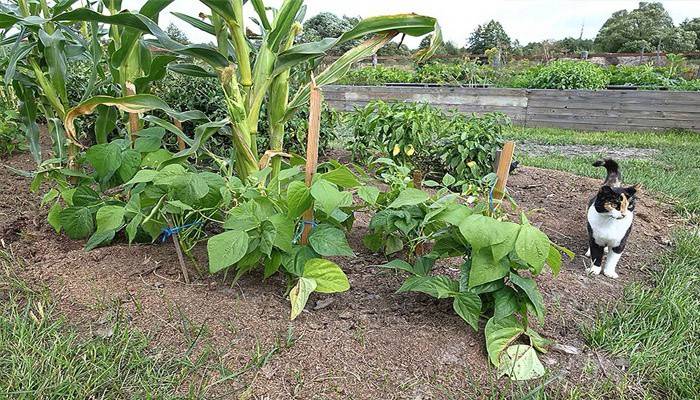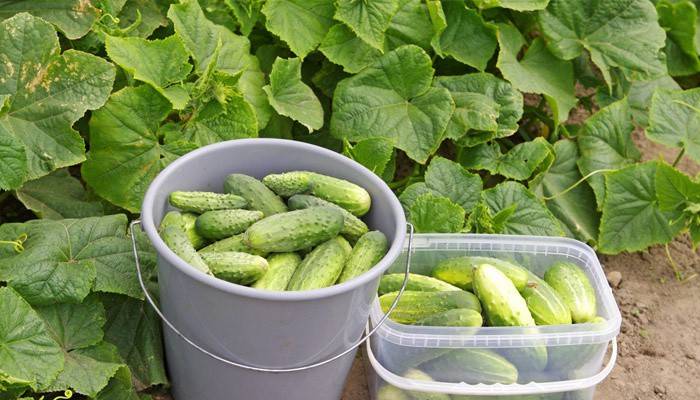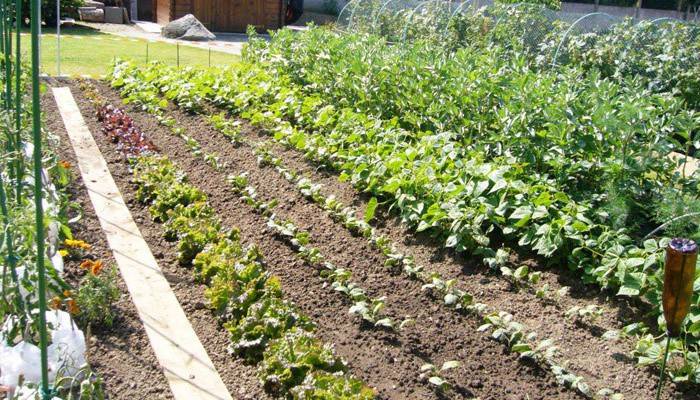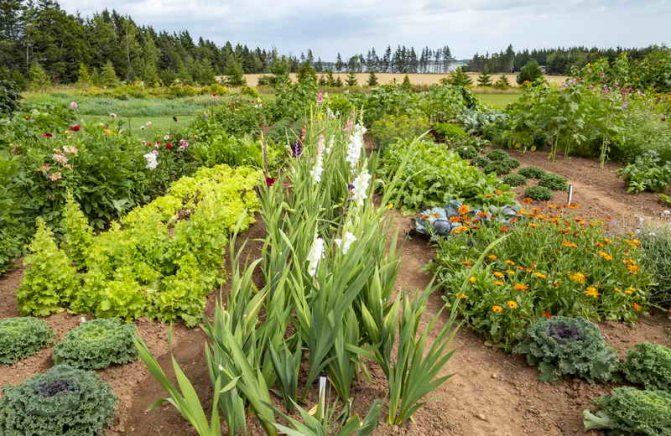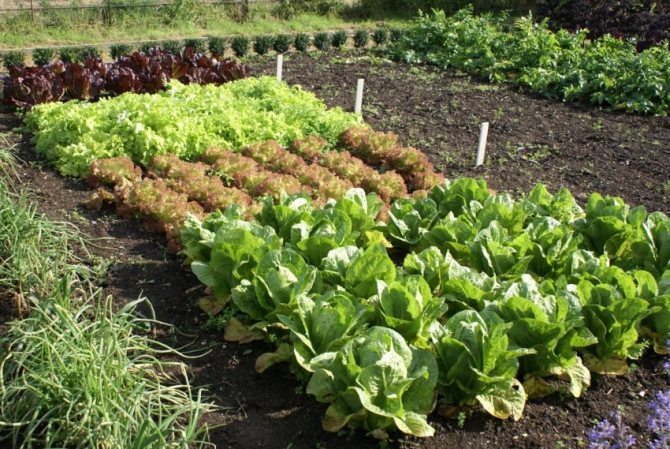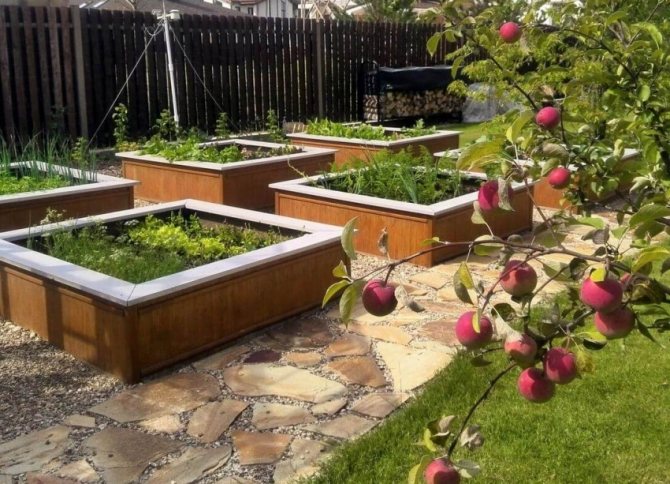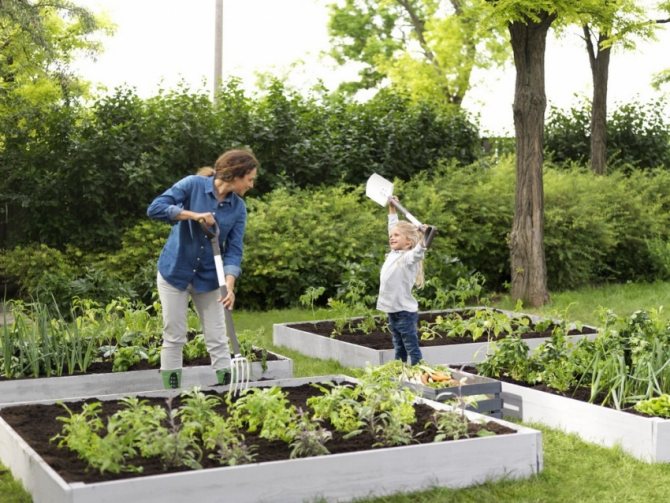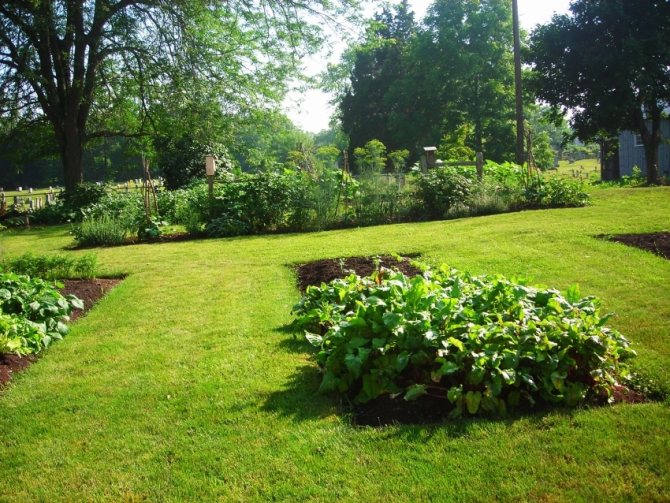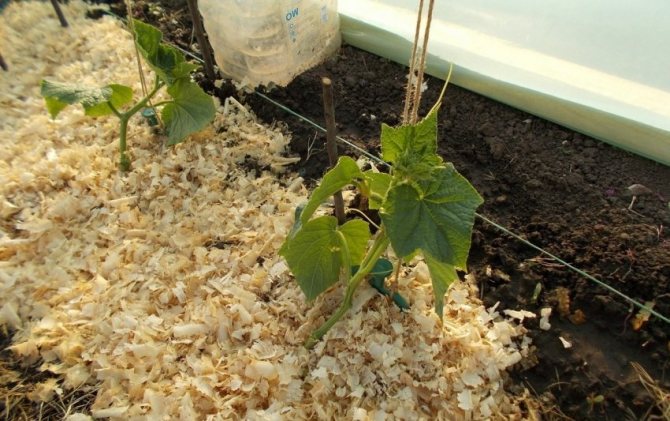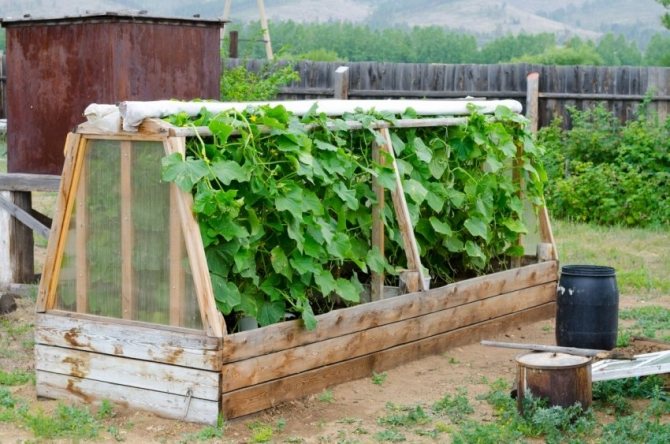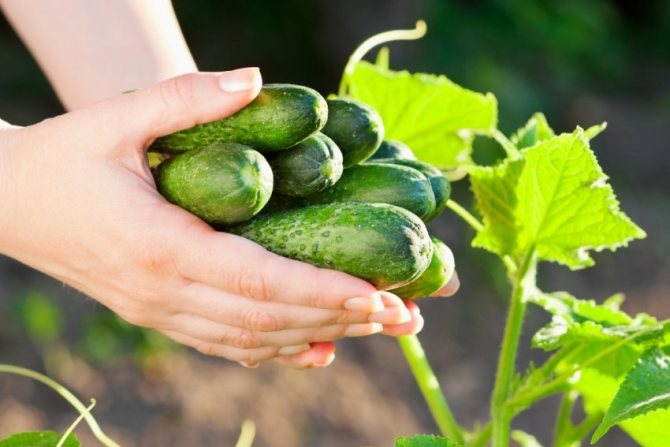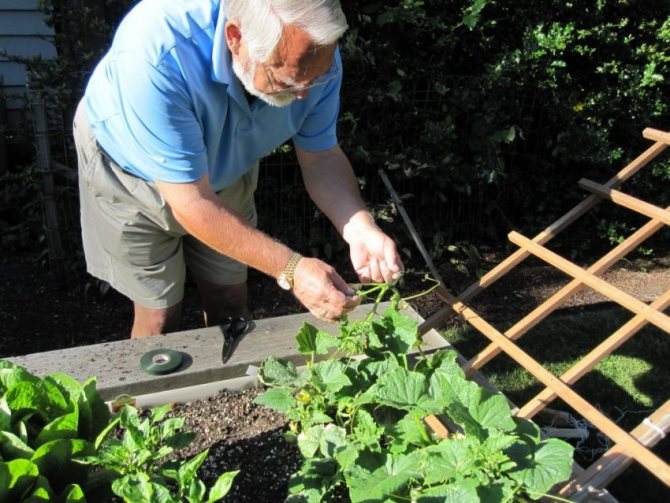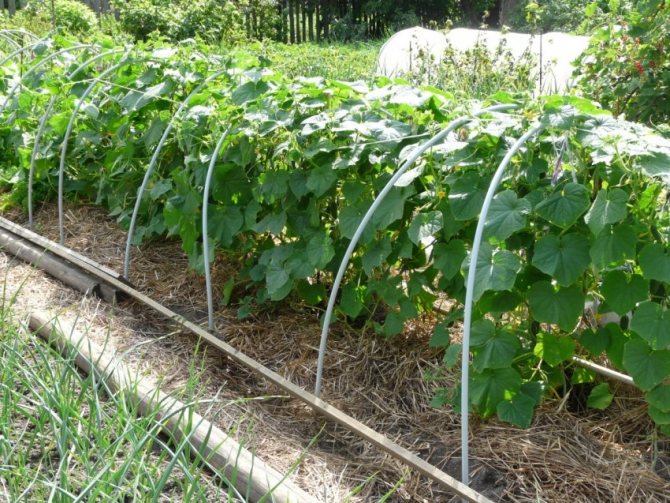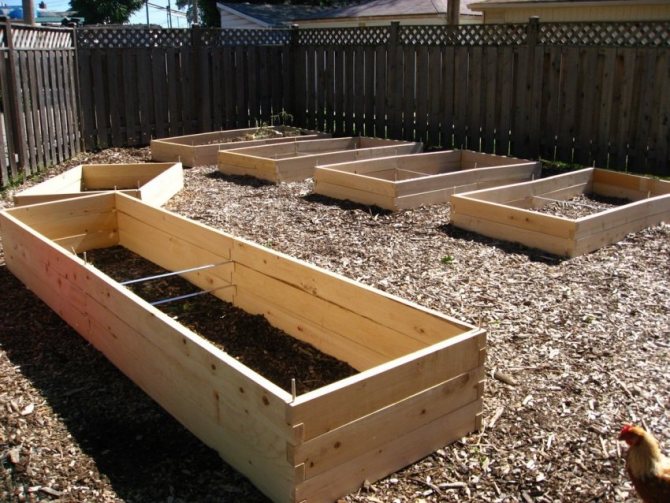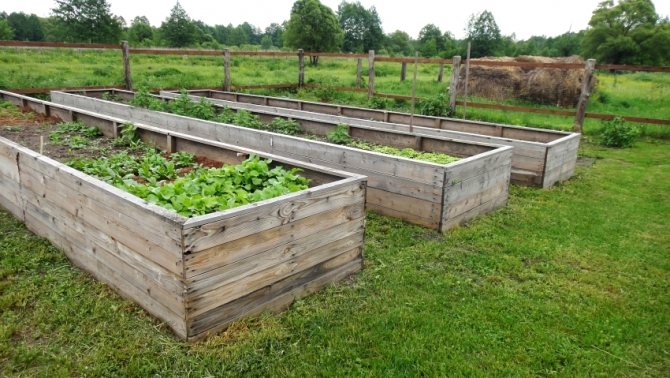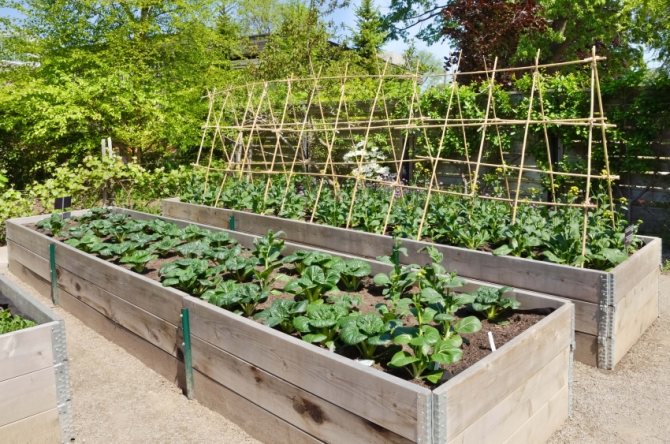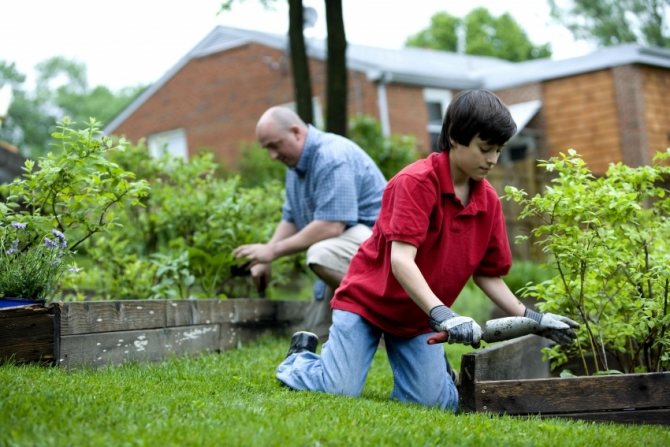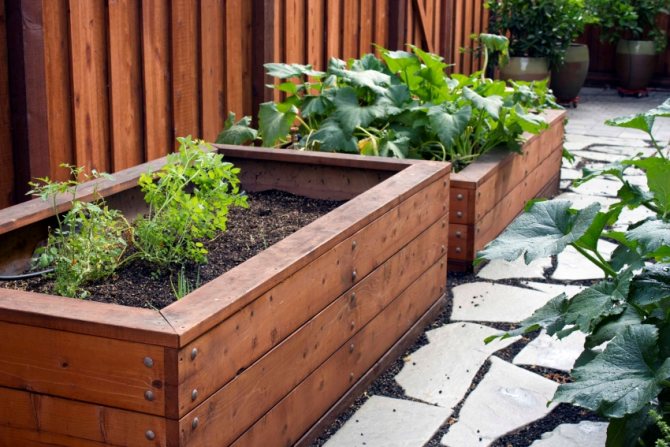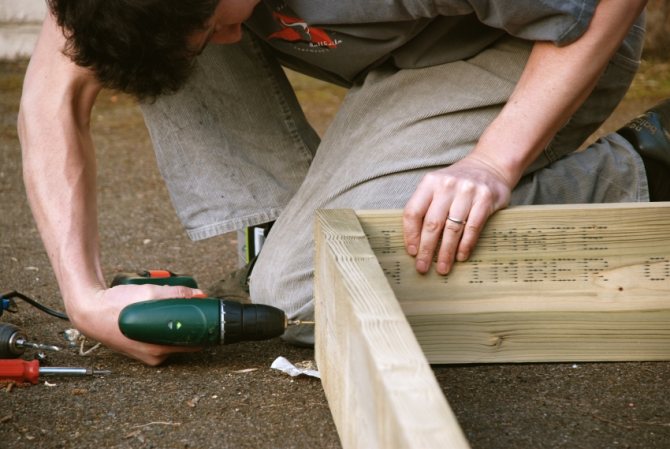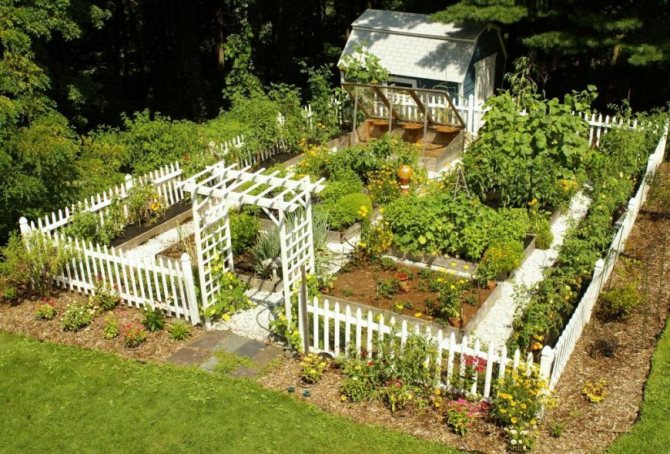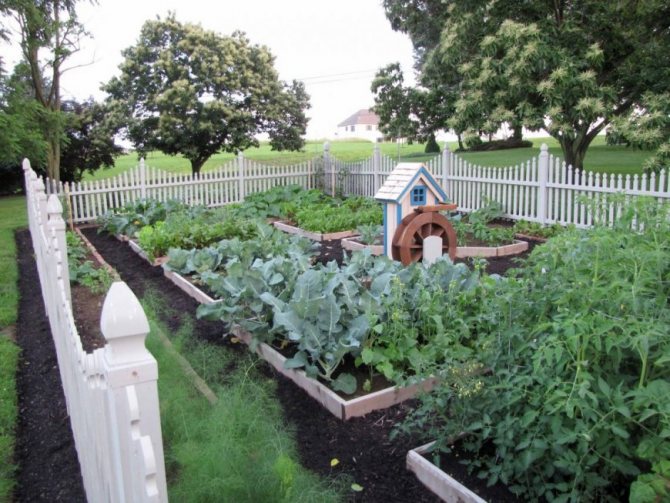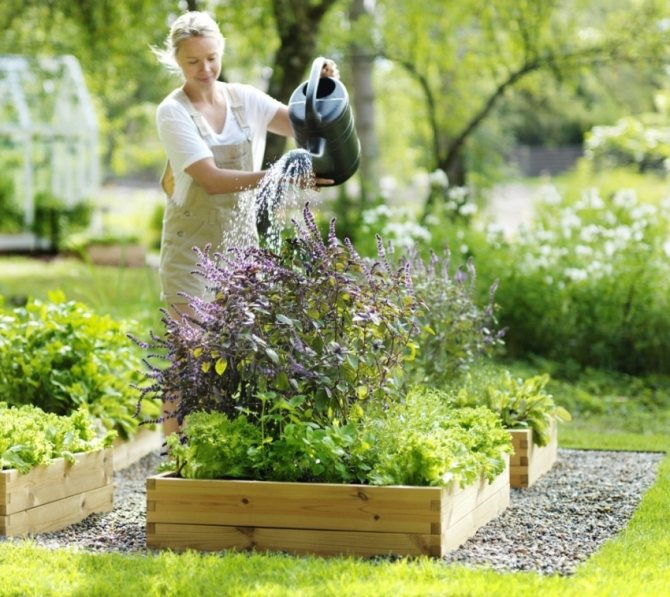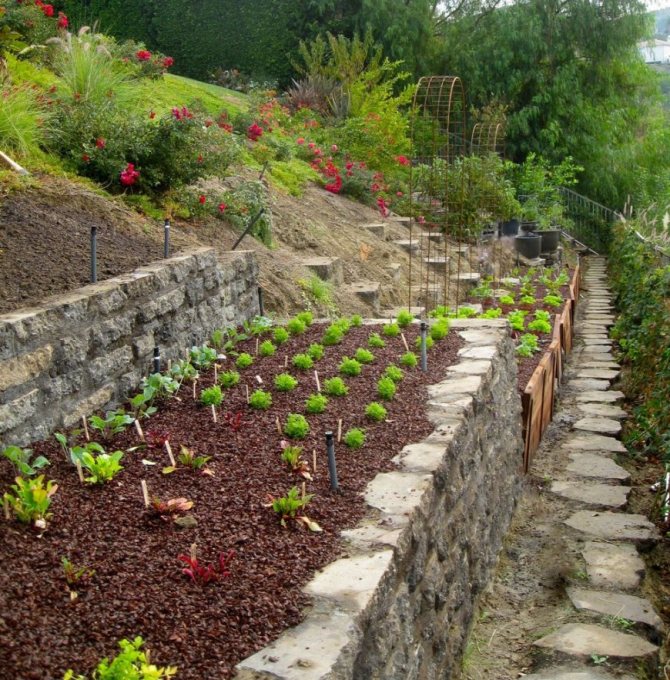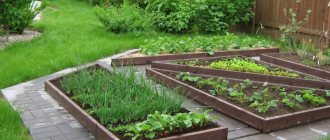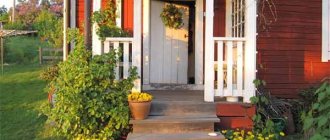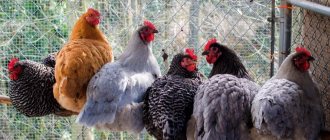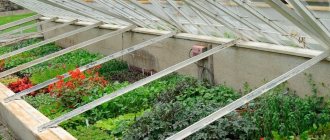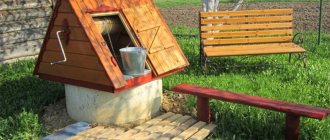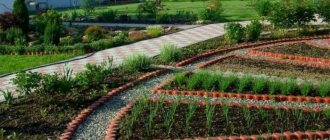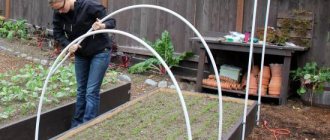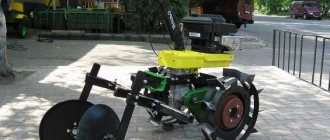This article discusses beds for the lazy: photos of the easiest structures to make for those who want to get a neat garden, while making a minimum of effort, the most common materials and technologies for creating structures based on them. The reader will learn how to combine vegetable crops on the same bed and prepare the soil for planting cucumbers. The article contains practical recommendations for novice summer residents.
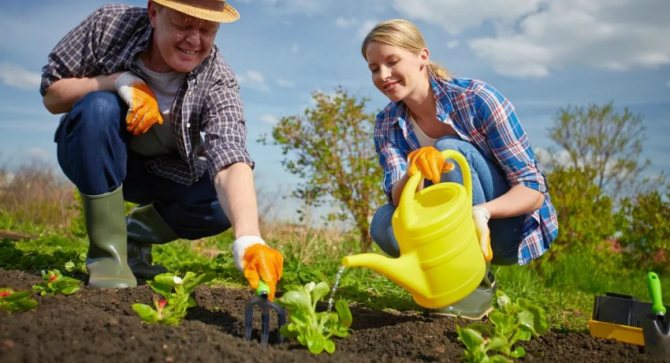
The correct organization of the beds in the garden will help save time and effort when planting and harvesting.
Garden rules for the lazy
A garden that does not need regular maintenance has been around for a long time. As a rule, such a garden is called "grandmother's" or "natural". Such areas do not require maintenance and bear fruit quite actively. However, it would not be grateful to leave such a garden completely without care.
Rules for caring for a small garden:
- No one has canceled the removal of weeds, and in order to reduce the frequency of harvesting, the beds can be covered with dry foliage.
- Watering is required as needed. To facilitate this process, you can use a drip irrigation system, and it is not necessary to purchase complex expensive devices. It will be enough to buy only the hose and the linkage.
- Every spring it is necessary to remove faded shrubs.
- Regular lawn mowing is also necessary. To make the whole process go faster, you can buy a good lawn mower that works with the least amount of waste.
- Standard tools (shovels, rakes, etc.) should be made from natural materials, not synthetic materials, to ensure a long service life.
- It is important and correct to arrange the recreation area, i.e. organize a place for installing a gazebo, barbecue and several benches. Around them, you can place several flower beds and fragrant trees, and flowering shrubs of lilac or fragrant jasmine.
As you can see, all these procedures are quite simple and do not require excessive efforts. For planning and decorating a garden, it is also better to choose non-whimsical plants and shrubs.
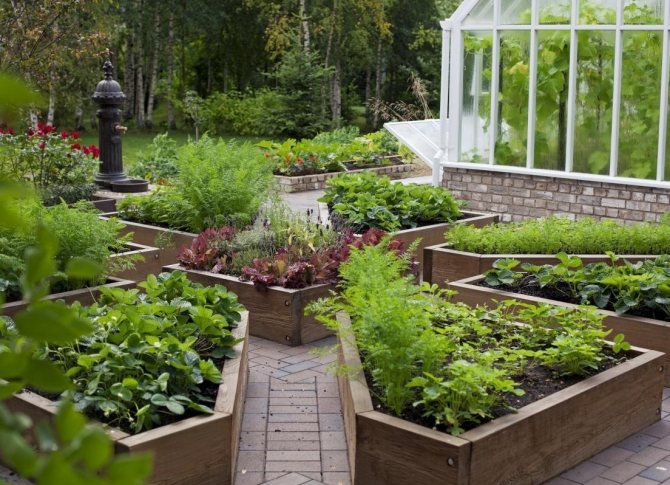

Plants for decorating a lazy garden:
- Barberry;
- Honeysuckle;
- Lilac;
- Rowan;
- Hydrangea;
- Spirea;
- Rhododendron;
- Narcissus.
When decorating a "lazy" site, remember that beauty in any case should be in the first place, therefore, it is important to observe the well-groomed appearance of all trees and beds. To do this, you should not get carried away with planting a large number of types of berries, cut sprawling shrubs in time, get rid of massive hedges and plant all crops, taking into account the prescribed planting rules, because this will save time in the future.
It is better to choose shrubs for planting that are neat and not too large - they do not need a regular haircut.
To make the site aesthetically pleasing, it is better to place mixed types of trees and unpretentious plants. For example, annuals such as sweet peas, snapdragons, calendula, and other annuals are suitable for this type of garden plot.In order to provide them with a lush and long flowering, it is recommended to plant them in well-lit and ventilated places, moreover, their seedlings should be started only in the first summer days, when all frosts have completely passed.
Organic farming in the country
Many residents of FORUMHOUSE are the most ardent supporters of the method of organic farming, in which the cultivation of fruits takes place in full harmony with nature, according to the principle "do not remake nature, but help it." Strict followers of this method do not use a shovel and hoe, do not remove weeds, and work for several days during the season - the rest of the time they harvest.
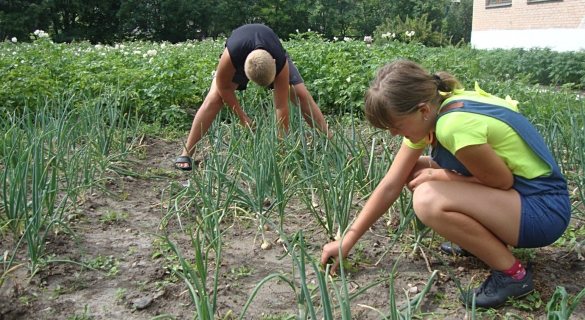

Basic principles of organic farming. Organic farming advocates:
- do not plow and do not dig up the ground, the maximum that is allowed is to loosen the soil with a Fokin flat cutter to a depth of 5-7 cm.
- never use herbicides. Good agricultural technology is the key to a healthy plant, and there are no aphids, fungal diseases, and the Colorado potato beetle in the gardens of well-known organists. And if diseases and pests do appear, they are treated with microbial solutions, folk remedies or biological products.
- do not use mineral fertilizers: you can only use compost, rotted manure, mulch, warm beds, etc.
- try to attract as many earthworms as possible to their site and stimulate the work of soil microorganisms.
- both beds and paths are actively mulching. Agronomist Nikolai Kurdyumov, the author of the “smart garden” system, says that mulching will not get rid of weeds at all, but it’s easier to “rip out one weed exhausted by the struggle for rooting” than to be on duty with a hoe all the time. But the main purpose of mulch is not even to combat weeds, but to maintain moisture, increase soil fertility and improve its structure.
Adhering to these principles on his site, the summer resident pursues three goals:
- increase soil fertility (every year it gets better and better);
- grow exceptionally healthy and tasty fruits without any chemistry;
- to reduce the time spent on work in the beds, to facilitate work.
But OZ in the farm requires exceptional consistency and high technological discipline! And without this it is better not to start.
Making garden design for the lazy
Of course, the easiest way to decorate a small area. For its furnishings, it is better to use natural materials, for example, stone, paving stones or brick. These natural ingredients will allow you to create smooth and even paths that do not require additional maintenance. They can be used to elegantly decorate the patio.
For the beauty of lawns, you can use artificial grass, which does not require regular watering, weeding and mowing.
Today, on sale you can find decorative coatings based on nylon and polymers, exactly repeating real grass. If desired, real plants can be placed in such a "lawn". For example, thuja will help cover up some irregularities on the walls of the house.


The main elements decorating gardens for the lazy:
- Various garden figures;
- Seedlings of perennial plants;
- Seedling of bulbous crops;
- Container type of plants (do not need earthen soil, are not subject to diseases and attacks of garden pests).
Landscape designers recommend combining paved paths and slightly raised brick beds.
Examples of mixed planting of vegetables in the garden: popular schemes
The most successful example of the compatibility of vegetable crops in the beds is the combination of carrots and onions. Onions, being an independent crop, can give about 2.5 kg of yield from one square meter of the garden. And carrots on the same exact area are capable of producing 6 kg of harvest. In the case of joint cultivation of these crops from one square meter, you can get about nine kilograms of vegetables.These crops will create a protective barrier for each other from insect-believers. For this reason, the efficiency of the used area increases.
Naturally, when planning the joint cultivation of vegetables in your garden, you should group the plants, taking into account their height, so that neither of them can block the light for the other. This is required, since vegetables can not only be different in their height, but also grow at different rates. It is best that the additional compactors you plant are slightly lower in height than the main crops.
The method of multi-layered neighborhood of vegetable crops in the beds helps to create excellent conditions for the root system of vegetables, and will also contribute to the rational use of seneca energy.
You can collect rich harvests from those beds where late cabbage beets will be planted. for this, beets (nine plants) and cabbage (four bushes) must be planted on an area of 0.8 by 0.8 m. In this case, you will need to fertilize the holes (one glass of compost and a handful of eggshells). To get a rich harvest when planting tomatoes and beans, we advise you to arrange the plants in a row with a step of 0.3 meters. And along the row of beans, you should install a drip irrigation system so that each plant is located at the dropper. Tomatoes should be planted in the center of the garden. As a result, the bean and tomato bushes must be staggered.
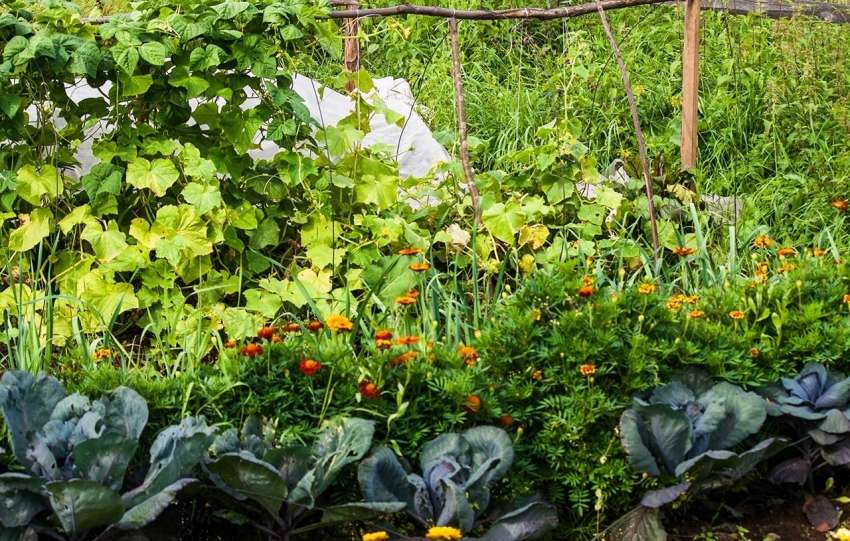

Table of crop rotation of vegetables in the beds by crop groups
A good harvest is also influenced by the crop rotation of plants. If every year you change crops in the right order, then your garden will be able to produce a good harvest.
The main advantages of competently building a crop rotation:
- The likelihood of soil fatigue in the garden is excluded, since the same vegetable crop will annually choose the same set of loop substances from the soil and they will do this from the same depth.
- The spread of various diseases and pests is prevented.
- The crop rotation of the plants can also affect the yield of the beds. If the annual change of crops grown in the same bed is carried out in the correct order, the vegetable garden will produce good yields.
- It will be possible to use fertilizers rationally.
The simplest method of organizing crop rotation on a bed is to plant plants of different families on the same bed and the same area every year. It is easiest to divide cultures into 4 groups:
- Legumes - chickpeas, beans, peas.
- Leafy - these include different types of green onions, cabbage, lettuce, etc.
- Root vegetables - beets, potatoes, carrots and radishes.
- Fruit - tomatoes, peppers, cucumbers, pumpkin, eggplants.
Arrangement of beds for cucumbers in the open field: photos and recommendations
Now let's talk about how to make a cucumber garden. For growing cucumbers in open soil, the beds should usually be prepared in the fall. And this procedure should be carried out before the onset of rains and freezing temperatures. the planting site of vegetable crops should be well dug up and organic fertilizers should be applied. cucumbers love light and fertile soil, which will have an excellent level of water permeability. In the event that the soil on the site is very heavy, then peat, sawdust and sand must be added to the soil to facilitate loosening.
The procedure for preparing beds for cucumbers in the spring includes soil disinfection. To do this, the site for the future garden should be shed with potassium permanganate. The solution must be strong and hot. In addition, you can increase the fertility of the soil by adding manure or chicken droppings to it. This procedure is carried out locally, that is, the fertilizer should be laid in a hole or trench. Then the bed should be covered with a small scrap of soil, where the seeds will then be planted.
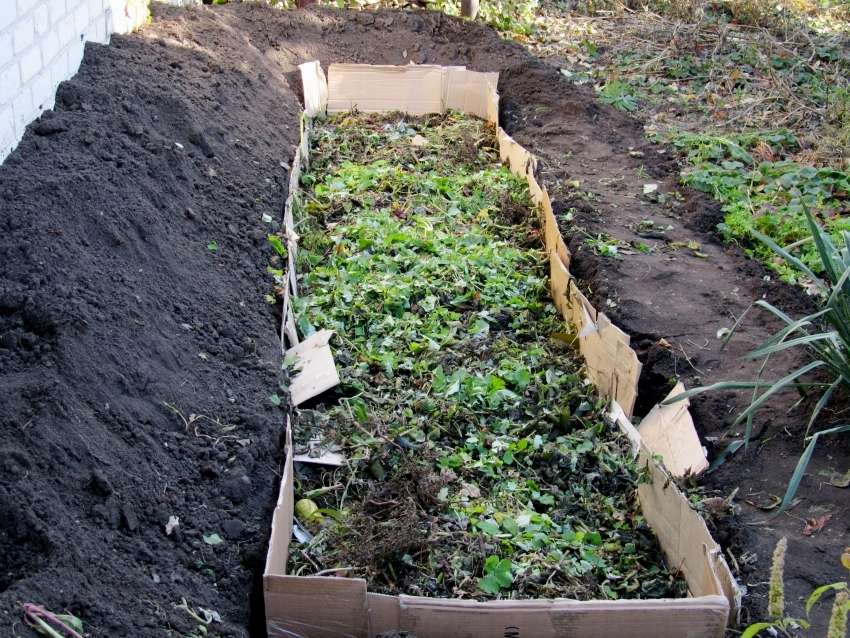

How to make a garden for cucumbers: agricultural secrets.
To get a good harvest of cucumbers from the garden, you should definitely adhere to the main rules:
- There should be no irrigation canals, flowing reservoirs and streams near the beds.
- If the planting site does not have protection, then it is better to place the vegetable garden in a quiet place, where there will be no drafts.
- Loosening and watering of the soil should be carried out constantly. Otherwise, a very hard crust forms on the surface of the bed.
- Cucumbers grown in open soil should be fed more often than those grown in closed beds.
- At the time of harvest, we do not advise you to change the position of the plant lashes or turn them over.
- The procedure for weeding plants in an open garden should be performed more often than in closed ground.
We advise you to cover the entire surface of the garden bed with black foil.
Cucumbers are in great need of a good biological composition of the soil. For this reason, we advise you to fertilize the soil with organic fertilizers, for example, humus, grass, branches, food waste or rotted manure. In the process of their decomposition, the fertility of the soil itself also increases, and heat begins to be released, which warms the soil. In order for the high temperature not to harm the root system of cucumbers, experienced gardeners recommend abundant watering.
There are several methods for growing cucumbers in open ground. For these purposes, you can equip a long bed-ridge, a hole, or dig a ditch or make a high structure.
How to make cucumber beds with a bookmark in the garden
To arrange a bed with a bookmark, you will need to dig a trench. The depth of the ditch must be equal to two shovels. Next, you should lay out the branches across and cover with sawdust. The next layer will consist of garden waste and straw. You can also add cardboard, newspaper, or fall leaves. The thickness of this layer will have to be in a pearl of five, seven centimeters. Next, fill the bookmark with warm water and cover the family, which will consist of soil and compost. A bed with a bookmark will serve you for five years; in the second year of its operation, you will not need to add compost to the top layer of the soil, since at the time of decomposition of organic elements, the bed itself will be able to develop nutrients.
Advantages of beds for growing cucumbers with a bookmark:
- Stagnation of water is excluded.
- Very convenient irrigation system.
- In the spring, there will be no need to dig up the soil, it just needs to be loosened up.
On this nutrient base, you can plant plants much earlier than it happens in ordinary beds. We do not advise you to use bookmarked beds in very low-lying areas and where water stagnates.
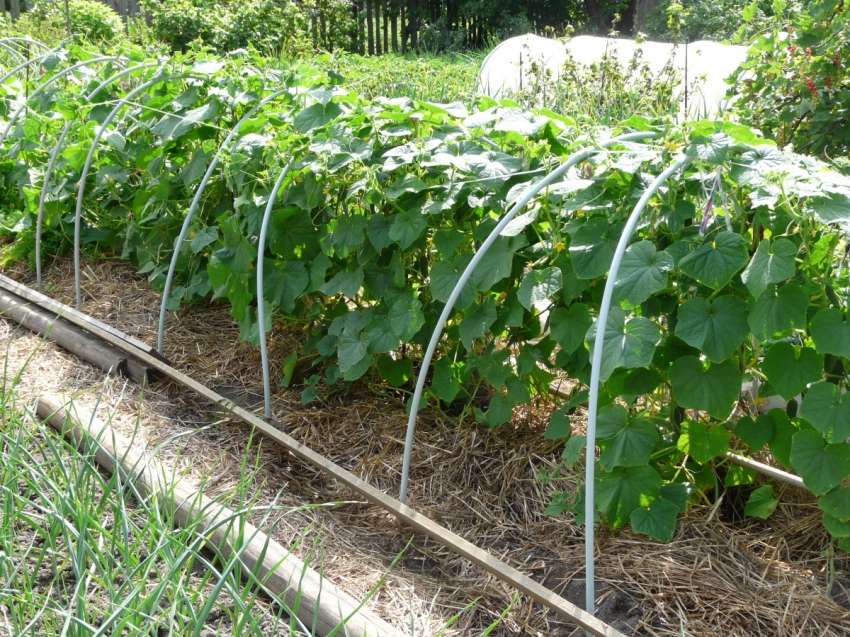

Warm surface beds for cucumbers in the open field
This type of warm beds for growing cucumbers is built on the surface of the prepared soil. This technique will be an excellent option for those places that are located in the lowlands. To enhance the heating process, the bed should be covered with PVC film. As a result, a greenhouse effect begins to be created, which has an excellent effect on the growth and productivity of cucumbers.
Surface beds should also include structures in the form of boxes made of slate, brick, or boards. The bottom of these containers is covered first with sand, and then with wood waste. Then a layer of organic waste and straw should be laid. After you put each component, all contents must be well tamped and filled with liquid manure. And then the bed should be covered with a mixture that will consist of soil and compost.
Planting of cucumbers is done in 2 rows.Plants should be placed along the edges of the box bed. Thanks to this, the required level of illumination will be provided. If the proposed planting of cucumbers begins in the spring, then you can convert the structures into a greenhouse. To do this, you will need to mount plastic arcs and stretch PVC film on top of them. As a result, the heating will increase and it will be possible to get a good early harvest.
The benefits of lazy do-it-yourself beds
Garden beds must solve several problems at the same time, more details about them are below.
Benefits of properly designed beds:
- The soil does not erode from moisture and is able to retain all substances useful for plants;
- All aisles between the planting beds are always free and clean;
- From the board beds, you can build a homemade greenhouse by covering the planting with a fixed film;
- Beautifully decorated seedlings perfectly decorate the adjoining terrace;
- The land in such beds does not need regular deep digging, it will only be lightly loosened;
- Weeds rarely penetrate such homemade beds.
Usually, do-it-yourself beds are made from ordinary wooden boards, old boxes, bricks or smooth pebbles. The size of such "containers" should not exceed 120 cm.
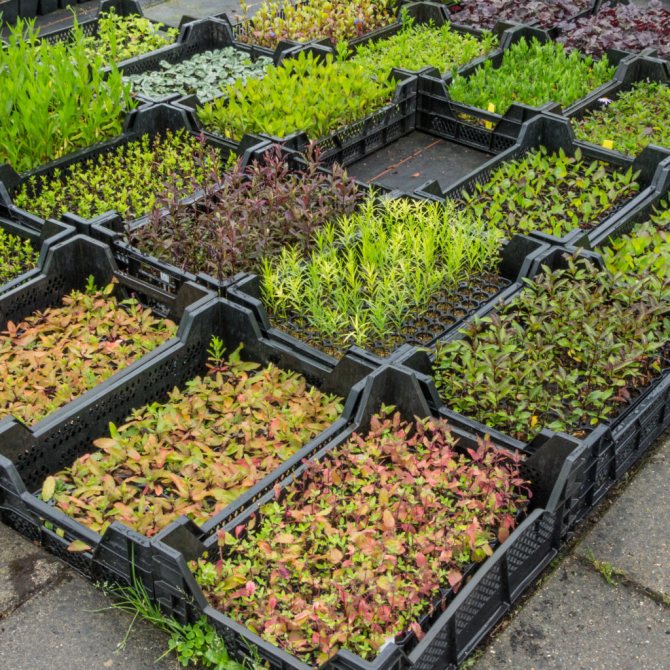

Homemade beds are filled as follows. We put brick chips or small stones at the bottom. Place manure and crushed sawdust on the top. Next, we put the dried leaves and grass. The obligatory layer is fertile soil, but its thickness should be about 20 cm. Each layer should be about 15 cm thick.
Testimonials
Ivan, 52 years old They completely abandoned the garden at the dacha, went only to have a rest. They gave him all their strength and time, and the harvest - to the chickens to laugh. I came across a book by Galina Kizima about a lazy vegetable garden. We made several beds in a lazy style, we fertilize with grass, vegetable peelings, free fertilization, but effective. We plant, take care less, and the harvest grows!
Tatiana, 37 years old I am fond of smart, lazy farming. I read a lot about this from Nikolai Kurdyumov and Pavel Trannoy. I especially like how straw mulch affects plants. It is humid under it even in the heat, when everything withers at the neighbors, my tomatoes, cucumbers and pumpkins are vigorous and green! I mulch abundantly everything, even the flower garden.
Vera, 42 years old In September, they harvested potatoes, on the advice of a neighbor, they sowed oats with peas. By the frost, greenery grew, about 12 cm, in winter it froze under the snow. The snow melted, the tops were raked from the site. Such land under it is luxurious, loose, they did not even cultivate it, they sowed carrots and beets. We are waiting for a good harvest!
Secrets of the lazy gardener
Any gardener dreams of a rich harvest, without excessive effort and exhausting physical labor. Such gardeners have come up with a few clever secrets that simplify suburban life.
Tips for simplifying summer cottage work:
- Do not use shovels or pitchforks to dig in the beds. The easiest way to loosen the soil is to use a flat cutter. It will allow you to mix the earth layers a little without damaging their fertility.
- It is better to dig holes no wider than 1 meter and no deeper than 70 cm. Such dimensions will provide all plants with good nutrition with nutrients and active growth.
- The beds must be insulated. To do this, it is necessary to add several layers of various fertilizers to the excavated soil (wood + ash, compost + ash, food residues).
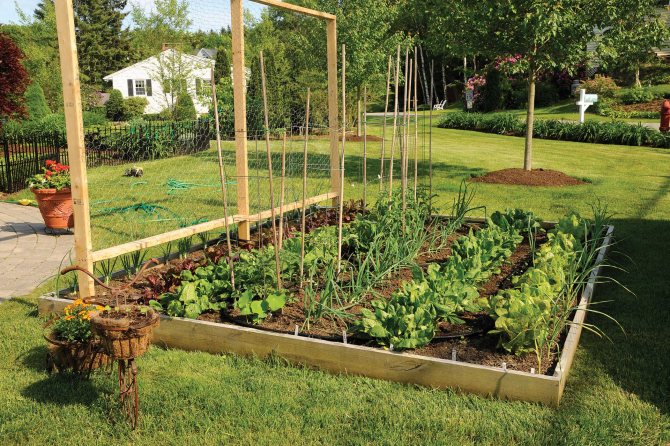

Interestingly, the regular addition of food debris, such as orange peels or eggshells to the soil, raises the temperature underground by about 5 degrees, compared to neighboring beds.
Rules for joint planting of crops
The planting principle is to grow different crops together. This approach allows vegetables to help each other, increases yields and protects against parasites. The proximity of beans and potatoes reduces the reproduction of the Colorado potato beetle. Marigolds protect cabbage from white butterfly.
Landings are also combined:
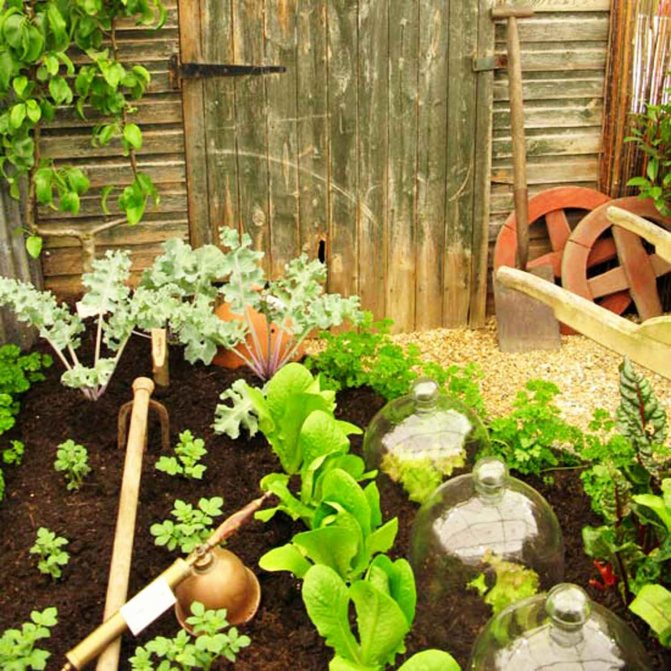

Carrots with tomato, corn, onion, lettuce, sage.- Peas with eggplants, cucumbers, corn, calendula, carrots.
- Beans with tomatoes, potatoes, strawberries, eggplants, cucumbers.
- Cabbage with beans, cucumbers, potatoes, onions, carrots, strawberries.
- Salad with radishes, cucumbers, carrots, strawberries.
- Tomatoes with parsley, nasturtium, beans, basil, calendula.
- Onions with celery, beets, carrots, tomatoes.
- Pepper with cucumbers, beans, salad.
- Strawberries with garlic, lettuce, spinach, beans, marigolds.
- Eggplant with peppers and beans.
- Pumpkin and zucchini with corn.
It is undesirable for lazy beds to be empty for a long time, since the plants feed the earth. After harvesting, the soil is planted with dill, lettuce or radish, enriching it with organic matter. In the future, the quality of the landings will significantly improve.
Summer cottage for the lazy: garden design according to all the rules
The design of the site is quite difficult, but exciting, in order for the process to be fruitful and bring pleasure from the work, you need to take into account several rules.
Rules and features of garden design:
- It is necessary to place all the beds, bushes and decorative figures taking into account the cardinal points.
- The northern part of the site is always in the shade, which is why it is recommended to place a recreation area in this area.
- The east side will be sunny from morning to evening, here you can install a small table and an armchair.
- The western part is well illuminated by the sun from about 12 noon until dark, here you can grow those crops that do not need abundant sunlight.
- However, it is better to grow all flower and fruiting crops in the southern half of the site, because the sun in these places is almost constant.
- It would be a good idea to divide the site into zones using a small fence and even an ordinary rope;
- For aesthetics, you can add decorative borders made of ordinary wood, watered with car oil.
- You can build flower beds out of handy materials, such as an old watering can, an unnecessary tire, and even a shabby bathtub.
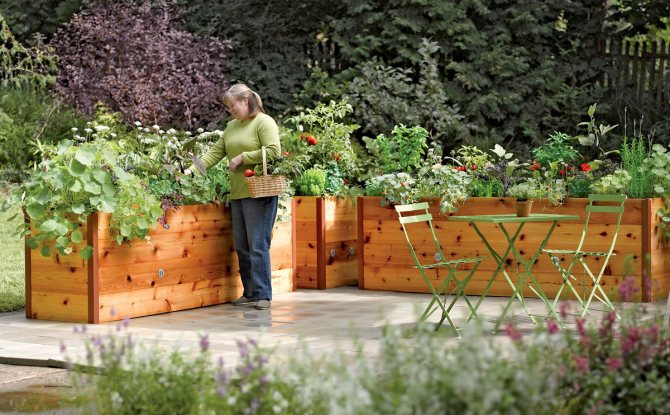

To decorate the garden, you can easily use your own imagination, and create beauty, focusing on the features of nature and local vegetation.
A summer cottage is a resting place for the soul and a decent shake-up for the body, but over time, the body gets tired, and the soul requires peace, it is for the fulfillment of such desires that a "light version" of the summer cottage was invented, which will allow you to simultaneously harvest and restore moral and physical resources.
Some tricks
The technology is called smart vegetable garden for good reason. You can test different approaches, novelties, experience of “colleagues”. There are a few tricks that come with use. We have already talked about one - about the covering material. It really makes maintenance a lot easier and you don't need mulch. There are more interesting ideas:
- After crops "heavy" for the earth, sow oats, peas, mustard, rapeseed. After a couple of weeks, juicy greens grow. You can leave it "under the snow", dig it up in the spring. Or dig it up just before the snow, along with the greenery. The purpose here is twofold - young greens rotting, enriching the land. This time. And two - weeds do not grow, as the seedlings are friendly.
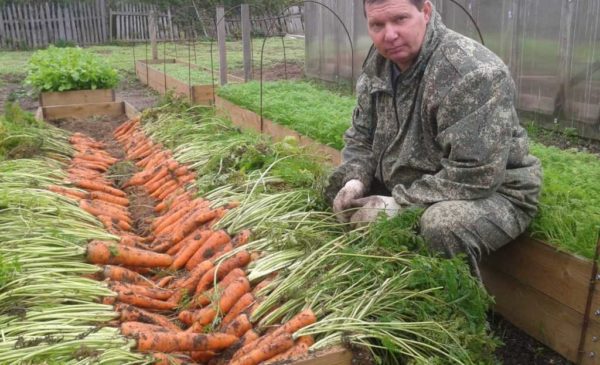

The heart rejoices at such a harvest
Surely there are more tricks in the processing of a smart vegetable garden. If we find out about them, then we will definitely supplement the article.
A garden and a vegetable garden for the lazy is the optimal solution for busy, working summer residents who have little time, but want to grow their own, environmentally friendly crop. We will help you create an area that will allow you to get an excellent harvest of fruits, vegetables and berries, without much time for maintenance.
Mulching
This is a real salvation for lazy gardeners. Thanks to them, the culture grows better, the weeds cannot break through, the fruits grow healthy and tasty.The mulch can be any material from straw to covering material.
For example, for strawberries, strawberries, a black covering material is ideal, which rid the berry of all weeds, protects from insects, unwanted whiskers do not have time to take root. And the berries grow beautiful and clean, do not rot.
In addition, this material passes the necessary fertilizers and water well, protects the soil from drying out. It is very convenient for those gardeners who can go to the country house only once a week. Covering material is best placed in two layers at once, as there are stubborn weeds that break through one layer.
Shrubs and trees can also be mulched with the same covering material, but cardboard is also added there. First, a black covering material is laid out around the trunk, thick cardboard is placed on top in two layers. After which it is all poured so that the paper softens.
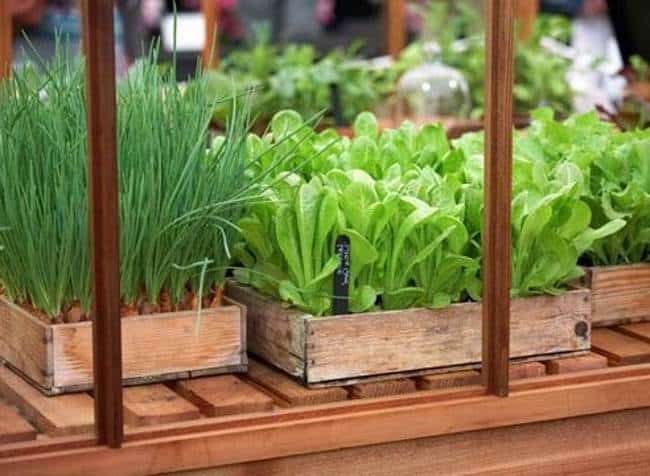

Then straw or sawdust is poured on top. Then the weeds under the bushes and trees will not bother you, and the soil will always be moist and loose. You need to water right under the bush. In any case, the plant will receive liquid.
Passages and paths are sprinkled with a thick layer of sawdust so that the ubiquitous weeds do not grow through them. The sawdust can be replaced with a thick layer of straw. However, in this case, there is a risk of a new weed. If finances permit, then all the aisles are covered with paving slabs.
You just need to remember that for the winter all the covering material must be removed, since mice and other pests can hibernate under it. Straw and sawdust can be left as they rot and turn into a good fertilizer.
Relaxation
In a lazy vegetable garden, there must be a resting area that can be planted with lawn grass. To create shade, you can plant tall trees, and stretch a hammock between them for relaxation. In the corner, put a barbecue grill. There should be a good canopy above it so that you can enjoy delicious kebabs even in the rain.
It will be ideal if there is a small gazebo in this corner for a pleasant pastime with family and friends. To create this cozy corner, show all your imagination and dreams, as you will come to the garden to relax in it.
A dacha and a vegetable garden, instead of a resting place, often become a place of exhausting work. Water, weed, loosen, water again, weed, loosen, and so on in a circle. At the same time, the harvest is not always happy. The situation can be changed. There is a special technology - a smart vegetable garden. The cultivated area decreases significantly, the amount of water required for irrigation decreases, and the yield increases. This is not a fairy tale. Many have already switched to smart beds and they are all happy with the result.


